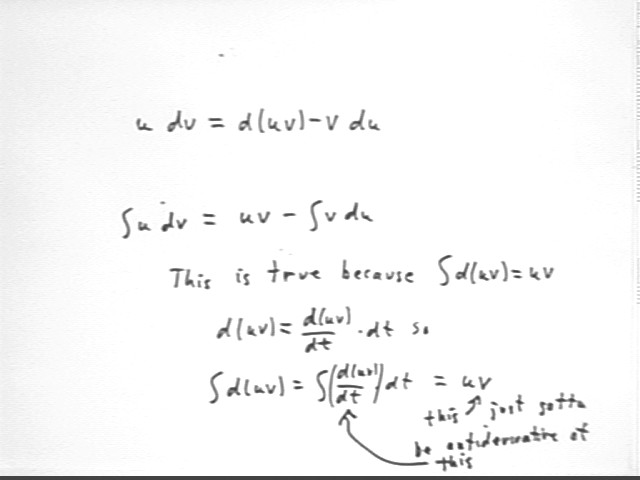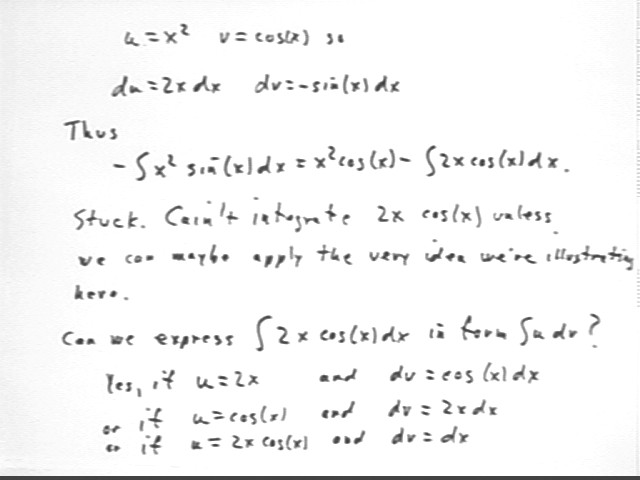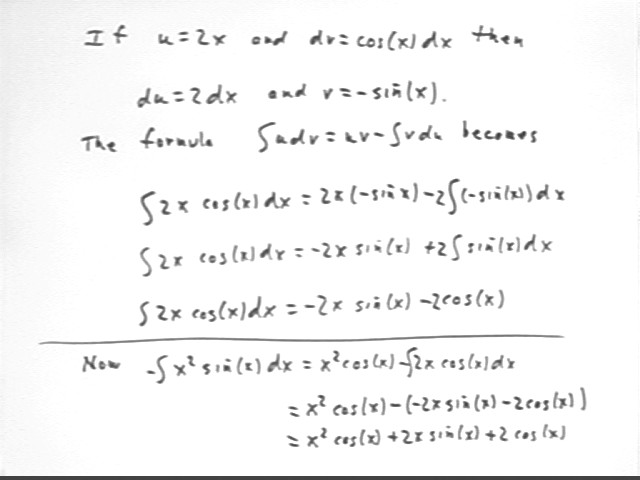
Calculus II Class 01/24
Calculus I Quiz 0124
Note that if u is a function of t then u ' = du / dt is equivalent to du = u ' dt.
We know that (uv) ' = u ' v + u v '. It follows that
d(uv) = v du + u dv.
Show that u dv = d(uv) - v du
This is a simple algebraic rearrangement of d(uv) = v du + u dv. Subtract v du from both sides and swap sides.
Explain why it follows that integral (u dv) = uv - integral (v du).
Thus we have the following formula, which is the formula for what we call integration by parts.
integral (u dv) = uv - integral (v du).

If u = x and v = cos(x) then what does the formula (u dv) = uv - integral (v du) tell us? Verify that the resulting equation is true.
The figure below shows this process.
If u = x then du = dx, and if v = cos(x) then dv = -sin(x) dx. So the formula (u dv) = uv - integral (v du) becomes
-integral( x sin(x) dx) = x cos(x) - integral (cos(x) dx)
We can evaluate the last integral, obtaining
-integral( x sin(x) dx) = x cos(x) - sin(x).
x cos(x) - sin(x) should therefore be an antiderivative to x sin(x), which we can verify by showing that (x cos(x) - sin(x))' = -x sin(x)

If u = x^2 and v = cos(x) then what does the formula (u dv) = uv - integral (v du) tell us? Verify that the resulting equation is true.
If u = x^2 then du = 2x dx, and if v = cos(x) then dv = -sin(x) dx. So the formula (u dv) = uv - integral (v du) becomes
-integral( x^2 sin(x) dx) = x^2 cos(x) - integral (2x cos(x) dx)

The first problem shows us the result of integrating 2x cos(x). However had we not had the first problem, we would have applied the integration by parts formula to this integral as follows:
To apply the formula we need to express 2x cos(x) dx in the form u dv. This gives us several choices for u and dv. We could try any of the following:
u = 2x, dv = cos(x) dx
u = cos(x), dv = 2x dx
u = 2x cos(x), dv = dx.
Applying the first 'breakdown' u = 2x, dv = cos(x) dx we obtain du = 2 dx, v = sin(x), as indicated in the figure below.
The formula for integration by parts then tells us that integral( 2 x cos(x) dx) = 2x * sin(x) - integral ( sin(x) * 2 dx) ). Simplifying and integrating the integral we obtain
integral( 2 x cos(x) dx) = 2x sin(x) + 2 cos(x).
We end up with
-integral( x^2 sin(x) dx) = x^2 cos(x) - integral (2x cos(x) dx) = x^2 cos(x) - (2x sin(x) + 2 cos(x)) = x^2 cos(x) - 2x sin(x) + 2 cos(x).
This integral can be verified by taking the derivative of x^2 cos(x) - 2x sin(x) + 2 cos(x). We end up with x^2 sin(x) dx.

From this example we see that a useful strategy when integrating the product of a power of x and a sine or cosine function, or an exponential function, can be to allow u to equal the power function so that du reduces the power of that function. Repeated application of this technique will continue to reduce the power of the function until we end up with a constant multiplied by a sine, cosine or exponential function. You will encounter this idea repeatedly in the assigned text problems.